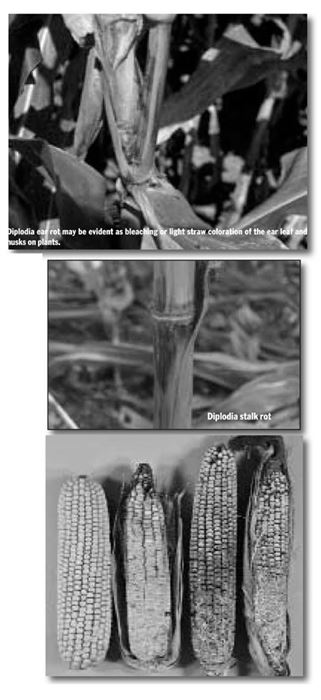Rotation Is Important In Managing Diplodia Ear Rot Of Corn
COLUMBIA, MO.
Diplodia ear rot was unusually widespread
and severe on corn throughout most of
Missouri during the 2009 season. It developed
again during the 2010 season in much of
the state although perhaps not as severe as in
2009. Since the primary source of inoculum for
the disease is diseased corn debris left in the
field and since corn debris may remain in a field
for several years, planting corn
in a field which had high levels
of Diplodia ear rot in 2009 or
2010 increases the risk of the
disease occurring in 2011
corn. The risk for Diplodia ear
rot will also be greatly influenced
by weather conditions
after silking with the risk being
the greatest if wet weather occurs
after silking. The following
article covers symptoms,
factors favoring disease development
and management options
for Diplodia ear rot of
corn.
Diplodia ear rot is caused by
the fungus Stenocarpella maydis
formerly known as Diplodia
maydis. When infection
occurs just after silking, the
ear leaf and husks on the ear
may appear prematurely
bleached or strawcolored. The
bleached ear leaf and husks stand out
in a very striking pattern against the
green foliage of the rest of the plant.
When the husk is peeled back, dense
white to grayish-white mold growth will
be matted between the kernels and between
the ear and the husks. In fact,
husks may be difficult to peel back on
ears with severe infections of Diplodia
ear rot. Small, black fungal fruiting
bodies may be scattered on husks or
embedded in cob tissues and kernels.
The entire ear may be grayish-brown,
shrunken, very lightweight and completely
rotted.
Stenocarpella maydis (Diplodia maydis)
can also cause a stalk rot of corn.
With the stalk rot, affected plants may
wilt, the foliage may appear off-color or
gray- green in color, the lower leaves
may become bleached in color and the
internal pith tissues of the stalk deteriorate
and disintegrate. Small, black
fungal fruiting bodies similar to those
formed on ears and cobs may also be
found in stalk tissues.
The primary source of inoculum is
diseased corn debris left in the field.
The small, black fungal fruiting bodies
embedded in stalk, cob and kernels
contain spores of the fungus. These
spores can be released the following
season to cause infection of the current
season’s corn crop. Wet weather favors
spore release and spread. During wet
weather the following season, the fungal
fruiting bodies produce spores
which may be spread to silks on current
season corn plants by splashing
rain. The fungus then grows down the
silks into the ears. The fungus may
also enter the husk by growing between
the ear shoot and the sheath of
the ear leaf. In this case infection may
be heaviest at the base of the ear. Insect
damage and bird damage may also predispose
corn plants to infection. Ears tend to be
most susceptible to infection for three weeks
after silking when silks are senescing. Diplodia
ear rot is favored by wet weather just after silking
and is more severe when corn is planted following
corn.

Four ears with ranging symptoms of Diplodia ear rot of corn.
Crop rotation is extremely important in attempting
to reduce the risk of Diplodia ear rot.
Because of the high level of fungal fruiting bodies
which may remain in infested corn debris
left in the field, the disease may be much more
severe if corn follows corn which had Diplodia
ear rot.
Hybrids do vary in their susceptibility to
Diplodia ear rot and stalk rot. Although published
ratings for Diplodia ear rot may be difficult
to find, most companies should have a good
idea of susceptible and more resistant hybrids.
Visit with your seed dealer about the reaction of
their hybrids to Diplodia ear rot, especially if it
is necessary to plant corn on corn in 2011. Δ
DR. LAURA SWEETS: Extension Associate Professor,
Plant Pathology, University of Missouri